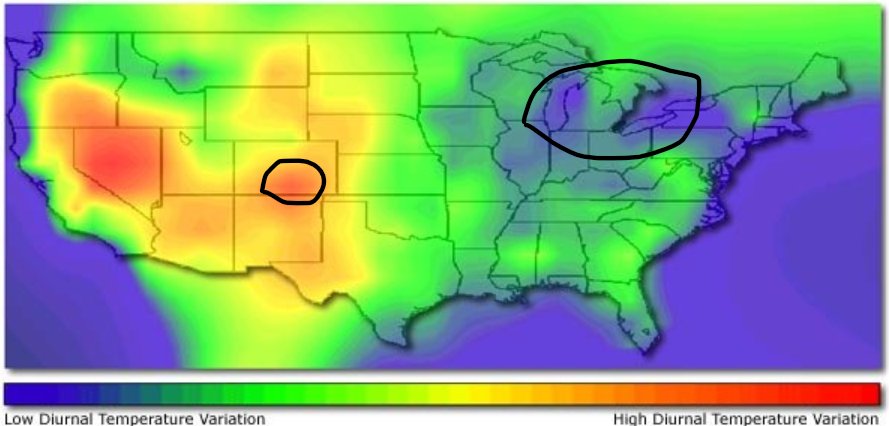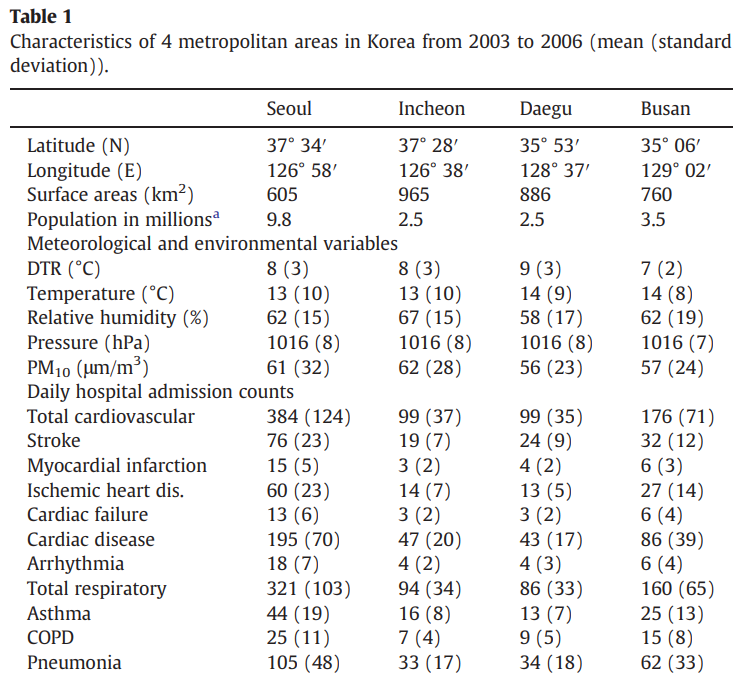Hello there; thanks for taking the time to read this piece of research. For my final piece of research, I decided to change things up. Instead of looking at a specific weather phenomenon, I looked at how the difference in high and low temperatures throughout the day affects human health and well-being. If you don’t know, the difference between the daily maximum and minimum temperatures is called the diurnal temperature range. To calculate this range, subtract the highest and lowest recorded temperature in a 24-hour period. This varies throughout parts of the Earth due to different climates, proximity to large bodies of water, and local geography. Urban areas tend to have a lower variation due to the artificial warming of asphalt and concrete. Different seasons affect the diurnal temperature range, with summer generally having the highest temperature range.
Earth’s average diurnal temperature range is about 25 degrees Fahrenheit (15 degrees Celsius) worldwide. Humid, tropical, and arctic regions tend to have less diurnal variations; for example, parts of the Great Lakes region of the United States may only have a 5-10 degrees Fahrenheit range. High and dry mountain valleys such as the San Luis Valley in Colorado typically have a daily temperature range of 40 degrees Fahrenheit or more. Since some areas can have extreme temperature variations, a question arises: how does a significant temperature variation affect human health? To find this out, I looked at a few research pieces.

Several recent studies have suggested a link between a high diurnal temperature variation and adverse effects on human health. Multiple papers and pieces of research have looked at how high diurnal temperature ranges can negatively affect human health in various ways. These papers examined how high-temperature ranges affect cardiovascular and respiratory hospital admission in Korea, childhood asthma in Brisbane, Australia, and blood pressure in Northwest China. I hope you will gain new knowledge from this paper.
The first paper: “Effects of diurnal temperature range on cardiovascular and respiratory hospital admissions in Korea”
The first piece of research I decided to look at is how high-temperature diurnal variation affects cardiovascular and respiratory hospital admissions in Korea. This paper was written by Yong-Hee Lim, Yun-Chul Hong, and Ho Kim and was published in 2012. The study looked at Korea’s largest cities (Seoul, Incheon, Daegu, and Busan) and used data from 2003 to 2006. The hospital information came from the National Health Insurance Corporation (KNHIC), which covers about 97% of the population. Heart-related diseases and respiratory diseases were examined for the study.
Temperature data, relative humidity, and PM10 concentrations were recorded and analyzed for environmental information. Two different models were used to perform the statistical analysis. The first one was the Poisson GLM, a generalized linear model used to count data and contingency tables. This model helped eliminate the liner effects of DTR on daily hospital administration from diurnal temperature variations. The other model used was the temperature-matched CC design, which helped control individual characteristics and remove seasonal trends.

The study’s result showed a significant increase in hospital administration for cardiac failure and asthma when the diurnal temperature variation increased. Unsurely, it was found that the elderly population and people with preexisting cardiovascular conditions and asthma are more vulnerable to high-temperature variations. Cities with a higher temperature variation had more administrations, with the city of Daegu, South Korea, having the highest DTR.
The study shows that a higher diurnal temperature variation is a significant predictor of hospital admissions for cardiovascular and respiratory issues documented in South Korea. This research shows that people with preexisting conditions and the elderly are more susceptible to higher DTR variations. Although the study answers some questions, more research is needed to fully understand the impacts of high DTR and increased cardiovascular and respiratory hospital administrations.
The Second Paper: “Diurnal temperature range and childhood asthma: a time-series study”
The next paper looked at the relationship between high diurnal temperature range and childhood asthma in Australia, specifically kids aged 0-14 years. This paper was written by Zhiwei Xu, Chnrui Huang, Hong Su, Lyle R Turner, Zhen Qiao, and Shilu and was published in 2013. Since this medical condition is widespread, much research has gone into the study of asthma, especially for children. Some of the factors that can cause asthma are viral infections, air pollution, and aeroallergens. The effects that a high DTR has on asthma have been under-studied.
The goal of this study is to examine the relationship between DTR and childhood asthma, identify the most vulnerable group of kids, and find if there is a delay effect of DTR on childhood asthma. To collect the data, emergency department admissions (EDAs) data for asthma were used among kids aged 0-14. For weather data, the maximum and minimum temperatures, relative humidity, seasonal patterns, and long-term trends were used. The seasonal influenza virus was also considered.
A poisson generalized linear regression model was used for the statistical analysis, and a distributed lag non-linear model (DLNR) was used. The analysis controlled for air pollutants means temperature, relative humidity, seasonal patterns, long-term trends, and seasonal flu epidemics. The effects of DTR were estimated for lags up to 11 days.
The results showed that 13,324 EDAs for asthma among children aged 0-14 during the study period. It was found that there is a significant relationship between high DTR and childhood asthma, especially if the DTR was above 10 degrees Celsius. The effects were found to be most significant for lag 0-9 days. Kids aged 5-9 years were the most vulnerable.
This paper has shown that changes in weather patterns impact the immune system, especially for those with asthma. When the temperature suddenly changes, it may trigger an inflammatory response in the respiratory system, leading to more severe cases of asthma. Some issues were encountered in the research, such as possible misclassifications and the limited generalizability of the condition.
The conclusion of this research showed a correlation between DTR and childhood asthma. As we continue to see the effects of climate change, this relationship between meteorology and the medical field will only become more critical. Although the answer was found with the research, more extensive studies need to be conducted to further confirm this theory.
The Third Paper: “The effect of diurnal temperature range on blood pressure among 46,609 people in Northwestern China”
The last paper that was looked at studied the effects of diurnal temperature range effects on blood pressure among people in Northwest China. This paper was written by Shan Zheng, Wenzhi Zhu, Minzhen Wang, Qin Shi, Yan, Luo, Qian Miao, Yonghong Nie, Feng Kang, Xiuying, and Yana Bai, and was published in 2020. Several studies have found a correlation between DTR and cardiovascular diseases, but more information is needed about how DTR affects blood pressure. This research hopes to find a correlation between these factors.
Between 2011 and 2015, 46,609 people were studied in the city of Jinchang City, Gansu Province in Northwest China. 60.45% were male, while 39.55% were female, with the average age being 46.96+-13.86 years. Weather data such as minimum and maximum temperature, mean wind speeds, pressure, and relative humidity were taken during the same period. The generalized additive model (GAM) was used to eliminate the relationship between DTR and blood pressure. During the study, the lowest and highest DTR variation was 3.4 degrees Celsius and 25.3 degrees Celsius, with the average temperature being 13.1 degrees Celsius.
It was found that there was a significant correlation between DTR and BP. When there was a greater DTR, the systolic and plus pressure increased and had an interactive effect with each season. It was found that the DTR had the greatest effects during the warm seasons. This shows that people who may suffer from blood pressure issues should be careful in areas that have a high diurnal temperature variation.
In conclusion, DTR does have negative effects on human health. One of the side effects of climate change is increased DTR in a given year. Because of this, we may start to see continued health effects related to DTR.
References
Lim, Y.-H., Hong, Y.-C., & Kim, H. (2012, January 25). Effects of diurnal temperature range on cardiovascular and respiratory hospital admissions in Korea. Science of The Total Environment. https://www.sciencedirect.com/science/article/pii/S0048969711015142?casa_token=LuIeM_riBzoAAAAA%3AX9RlMgjFMxlKW9Y7kbHVTB_21jbkbHAb3n7VgRZXw47Pu_aGQstg7IUE7Vou7vkQIopG4MLung
Weather variety – diurnal temperature variation. weatherpages.com. (1998). https://weatherpages.com/variety/diurnal.html
Xu, Z., Huang, C., Su, H. et al. Diurnal temperature range and childhood asthma: a time-series study. Environ Health 12, 12 (2013). https://doi.org/10.1186/1476-069X-12-12
Zheng, S., Zhu, W., Wang, M., Shi, Q., Luo, Y., Miao, Q., Nie, Y., Kang, F., Mi, X., & Bai, Y. (2020, April 26). The effect of diurnal temperature range on blood pressure among 46,609 people in northwestern China. Science of The Total Environment. https://www.sciencedirect.com/science/article/abs/pii/S0048969720325043?fr=RR-2&ref=pdf_download&rr=8ab05b5e0c685390#preview-section-snippets

